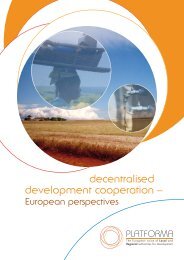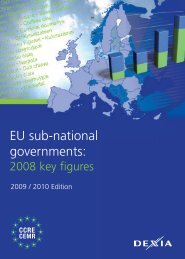Complementarities between urban and rural areas in promoting ...
Complementarities between urban and rural areas in promoting ...
Complementarities between urban and rural areas in promoting ...
Create successful ePaper yourself
Turn your PDF publications into a flip-book with our unique Google optimized e-Paper software.
COMPLEMENTARITIES BETWEEN URBAN AND RURAL AREAS IN PROMOTING EMPLOYMENT AND SOCIAL INCLUSION●●Here, benchmark<strong>in</strong>g is a useful <strong>and</strong> importanttool for promot<strong>in</strong>g employment <strong>and</strong> social <strong>in</strong>clusionprogrammes at the local <strong>and</strong> regional levels.The availability of comparative data or <strong>in</strong>formationon the exchange of experience on particularfeatures of social problems <strong>in</strong> <strong>urban</strong> <strong>and</strong> <strong>rural</strong>communities, <strong>and</strong> on approaches towards solv<strong>in</strong>gthese, can contribute to the development ofmutually complementary approaches <strong>in</strong> differentpolicy sectors. It is important to furtherdevelop the tools applied here to make benchmark<strong>in</strong>gmore adaptable to the specific needs ofthe different <strong>areas</strong> <strong>and</strong> to simultaneously allowthe coord<strong>in</strong>ation of a balanced <strong>rural</strong> <strong>and</strong> <strong>urban</strong>development.The Urban Audit has produced a great deal of<strong>in</strong>formation on the problems <strong>and</strong> developmentissues of cities. Although it is important tomonitor the development of large cities, theUrban Audit should be extended to <strong>in</strong>cludemedium-sized cities <strong>and</strong> the <strong>in</strong>formation should,<strong>in</strong> order to improve the <strong>urban</strong> - <strong>rural</strong> balance, bestudied from the perspective of the region/<strong>rural</strong><strong>areas</strong> adjacent to cities. Small <strong>and</strong> medium sizedtowns are important centres <strong>in</strong> predom<strong>in</strong>antly<strong>rural</strong> <strong>areas</strong>. They should receive more support <strong>in</strong>order to ma<strong>in</strong>ta<strong>in</strong> the viability of the surround<strong>in</strong>gcountryside.3.3. GOVERNANCE, NETWORKING ANDPARTNERSHIP AS CRUCIAL ELEMENTSFOR BALANCED RURAL AND URBANDEVELOPMENT●●Keep<strong>in</strong>g <strong>in</strong> m<strong>in</strong>d the pr<strong>in</strong>ciple of subsidiarity,there should be a greater recognition that local<strong>and</strong> regional authorities are at the forefront oftackl<strong>in</strong>g social exclusion <strong>and</strong> unemployment <strong>and</strong>that they have an important role <strong>in</strong> f<strong>in</strong>d<strong>in</strong>g practical<strong>and</strong> immediate solutions. This has alreadybeen demonstrated by URBAN <strong>and</strong> LEADER programmeswhere municipalities are often thema<strong>in</strong> actors <strong>in</strong> implementation processes.Cohesion policy should promote <strong>and</strong> strengthenthe roles of the local <strong>and</strong> regional authorities <strong>in</strong>●order to further develop its’ goal of social <strong>in</strong>tegration<strong>and</strong> to dissem<strong>in</strong>ate best practice. Spatialregional plann<strong>in</strong>g as well as the creation <strong>and</strong>test<strong>in</strong>g of the new <strong>in</strong>stitutional forms <strong>and</strong> policy<strong>in</strong>struments that <strong>in</strong>tegrate <strong>urban</strong> <strong>and</strong> <strong>rural</strong>concerns can lead to a better economic developmentof both <strong>areas</strong>. Only a comprehensive <strong>and</strong><strong>in</strong>tegrated network strategy can tackle <strong>urban</strong><strong>and</strong> <strong>rural</strong> issues. This should also be the natureof a European <strong>urban</strong> <strong>and</strong> <strong>rural</strong> policy, as opposedto a sector-based approach.Partnership <strong>and</strong> network<strong>in</strong>g <strong>between</strong> <strong>rural</strong> <strong>and</strong><strong>urban</strong> <strong>areas</strong> should not only be promoted atregional level but also at the <strong>in</strong>terregional <strong>and</strong>transnational levels. Good examples for this typeof cooperation have already been provided byINTERREG programmes. Networks <strong>between</strong> <strong>urban</strong><strong>and</strong> <strong>rural</strong> <strong>areas</strong>, especially on an EU-wide level,could facilitate mutual learn<strong>in</strong>g.3.4. THE CAP SHOULD EMPHASIZETHE CREATION OF A MORE DIVERSERURAL DEVELOPMENT●●There has been a strong emphasis on shift<strong>in</strong>g thefocus towards <strong>rural</strong> development <strong>in</strong> the preparationsfor the reform of the common agriculturalpolicy (CAP). The CAP, as it is currently constituted,is unsusta<strong>in</strong>able both with<strong>in</strong> the EuropeanUnion <strong>and</strong> on a global level. It is therefore necessaryto <strong>in</strong>clude development measures outsideagriculture <strong>in</strong>to these programmes <strong>and</strong> to supportthe experience <strong>rural</strong> <strong>areas</strong> have <strong>in</strong> the developmentof non-agricultural economic activities<strong>and</strong> other <strong>rural</strong> developments.The opportunities for establish<strong>in</strong>g last<strong>in</strong>g <strong>and</strong>viable small <strong>and</strong> medium-sized bus<strong>in</strong>esses <strong>in</strong><strong>rural</strong> <strong>areas</strong> should be supported. Such bus<strong>in</strong>essescontribute to a balanced development of <strong>rural</strong><strong>areas</strong> <strong>and</strong> their pr<strong>in</strong>cipal towns. Lessons shouldbe drawn from earlier experiences with Article33 so that development measures outside ofagriculture <strong>and</strong> forestry would be <strong>in</strong>cluded <strong>in</strong>this form of aid to a greater extent. This wouldmean that small bus<strong>in</strong>esses <strong>in</strong> <strong>rural</strong> <strong>areas</strong> would— 9 —














![[ ] Les jumelages pour le monde de demain](https://img.yumpu.com/29721946/1/190x96/-les-jumelages-pour-le-monde-de-demain.jpg?quality=85)

